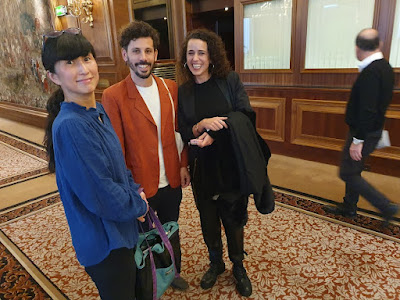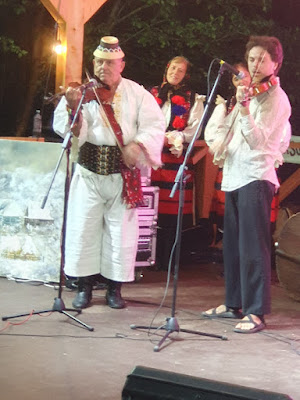 |
| Fumie, Leandro, and Paloma |
Some years ago I was approached by a young couple from Argentina at the Krakow Klezmer festival. Paloma Schachtmann and Leandro Koch were making a documentary about Klezmer music and they wanted to accompany me and Jake Shulman-Ment on one of our summer trips around Maramures to record fiddlers who retained a knowledge of Jewish repetoire. I don't always like traveling with a cohort of folks I do not already know, but they turned out to be fine traveling companions. I didn't hear about the project for a couple of years and then in 2020 they contacted me again. They had recieved funding to finish the film with a group of Austrian film makers and could we go on the road with a full film crew again? Covid intervened, but the next year we went to Tranylvania with them. They turned out to be some of the nicest film folks I ever met. (Note: I rarely say anything nice about film makers once they finish paying me.) The result was "The Klezmer Project" or "Adentro mio estoy Bailando" which premiered at the 2023 Berlin Fim Festival, winning the Best First Feature award. The Austrian premier happened a few weeks ago at the Viennale Film Festival in Vienna, and we were invited to attend.
The film is like nothing I had expected - not a simple documentary about collecting folk music, but an experimental fim that works on many levels - a romance, a road film, a I.B. Singer Yiddish allegory, and of course, a documentary. The narration in Yiddish tells a tale that transcends the scenes of film financing, backstage at gigs, and weddings in Maramures, Moldavia, and Argentina. The end result is something I am really proud to have been a part of, and when this film finally gets to widespread distribution I hope it gets seen at festivals of Yiddish culture: it is probably the most contemporary Yiddish film of this generation. In any case... the Viennale was a great excuse to visit Vienna. We got to stay in the Hotel Intercontinental downtown next to the Stadtspark. Not shabby at all!
Plus, the Viennale staff handled everybody with VIP courtesy, no eay task when the VIPs are hundreds of quirky avant-garde types whose stories always begin with "When I was kicked out of film school...". We checked in with the office and were given swag bags with info and gifties and shown a refrigerator full of refreshments to which we could help ourselves while in the hotel. I like swag bags! I like free beer! Plus: the Viennale hosted a dinner each evening at classic Viennese restaurants of the sort that I would probably never visit on my own dime (I'm more of a felaful and chinese noodle kind of guy on the road.) Of course, if traveling in Vienna, there are certain prosaic pleasures that are not to be missed: such is the Wurtelstand.
Wurstelstands are located all over Vienna and offer the street level diner a quick and cheap Teuronic standard, the wurst. For about three Euros you get a choice of bratwurst, boerwurst, frankfurter, or the odd construct that is a bosna. Everybody says to go for the käsekrainer, a kolbasz laced with cheese that is the darling of the Austrian Wurstiverse but just seems like a Polish kielbasa that is trying too hard. There are also Leberkäse sandwiches, a thick steamed slice of square veal baloney on a kaiser roll that fills you up as you hop on the tram.
 |
| Bratwurst and käsekrainer in the park. |
 |
| Brunnergasse Market |
 |
| Syrian breakfast |



































